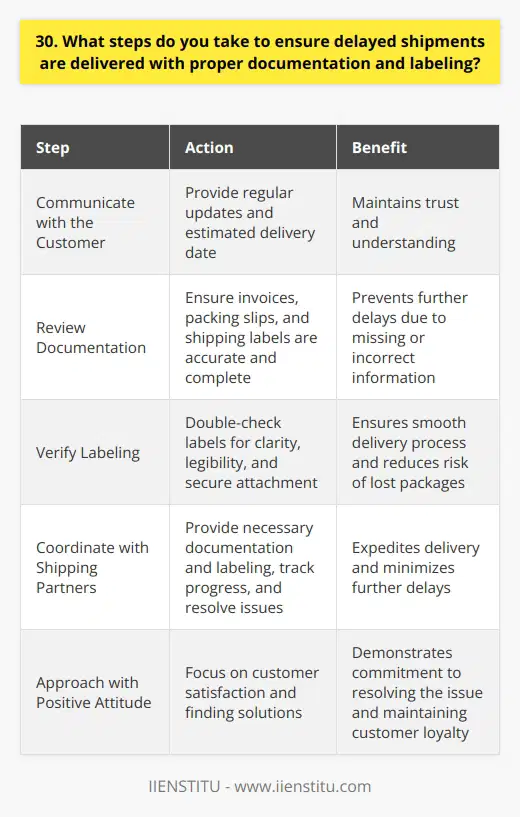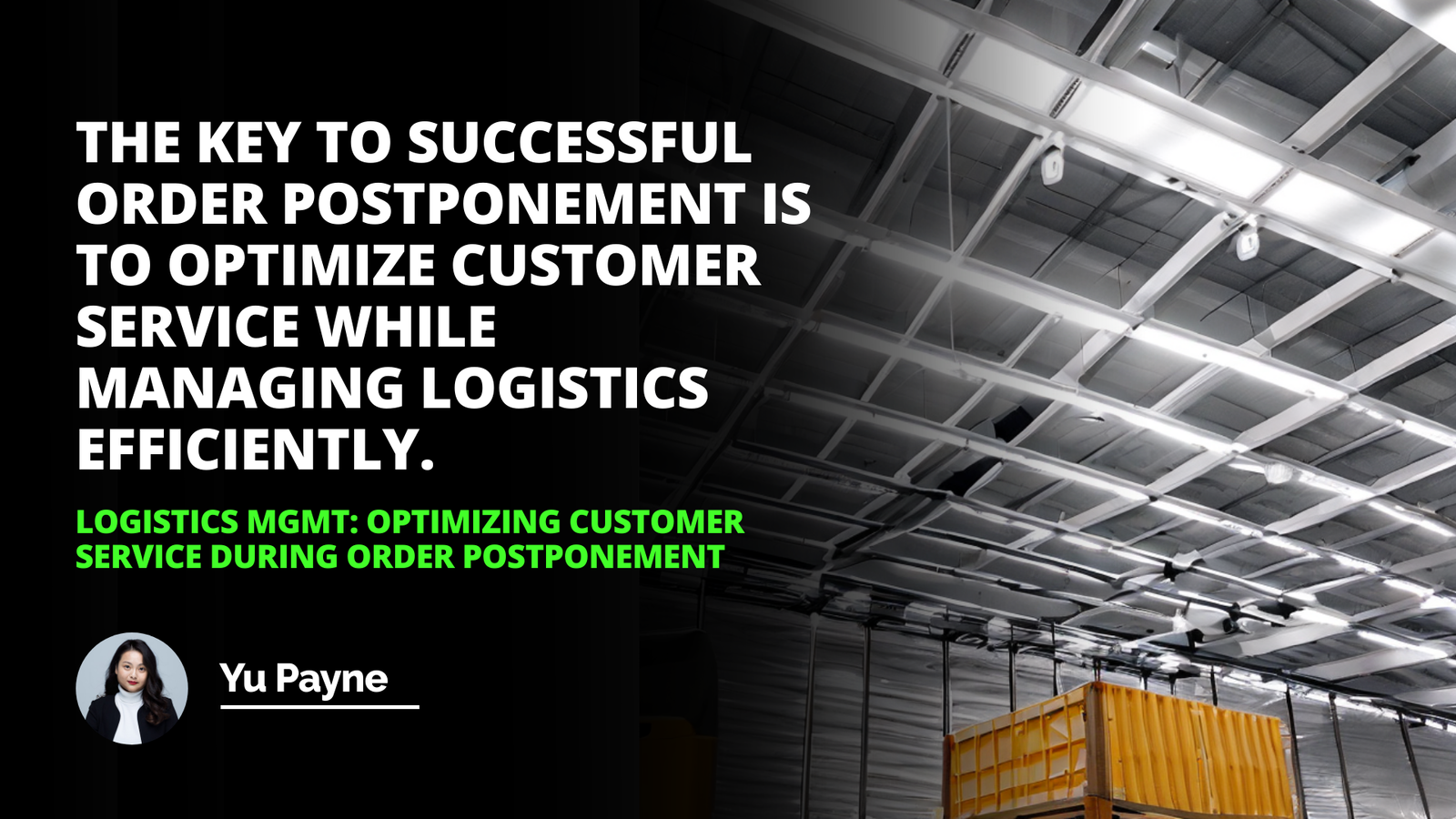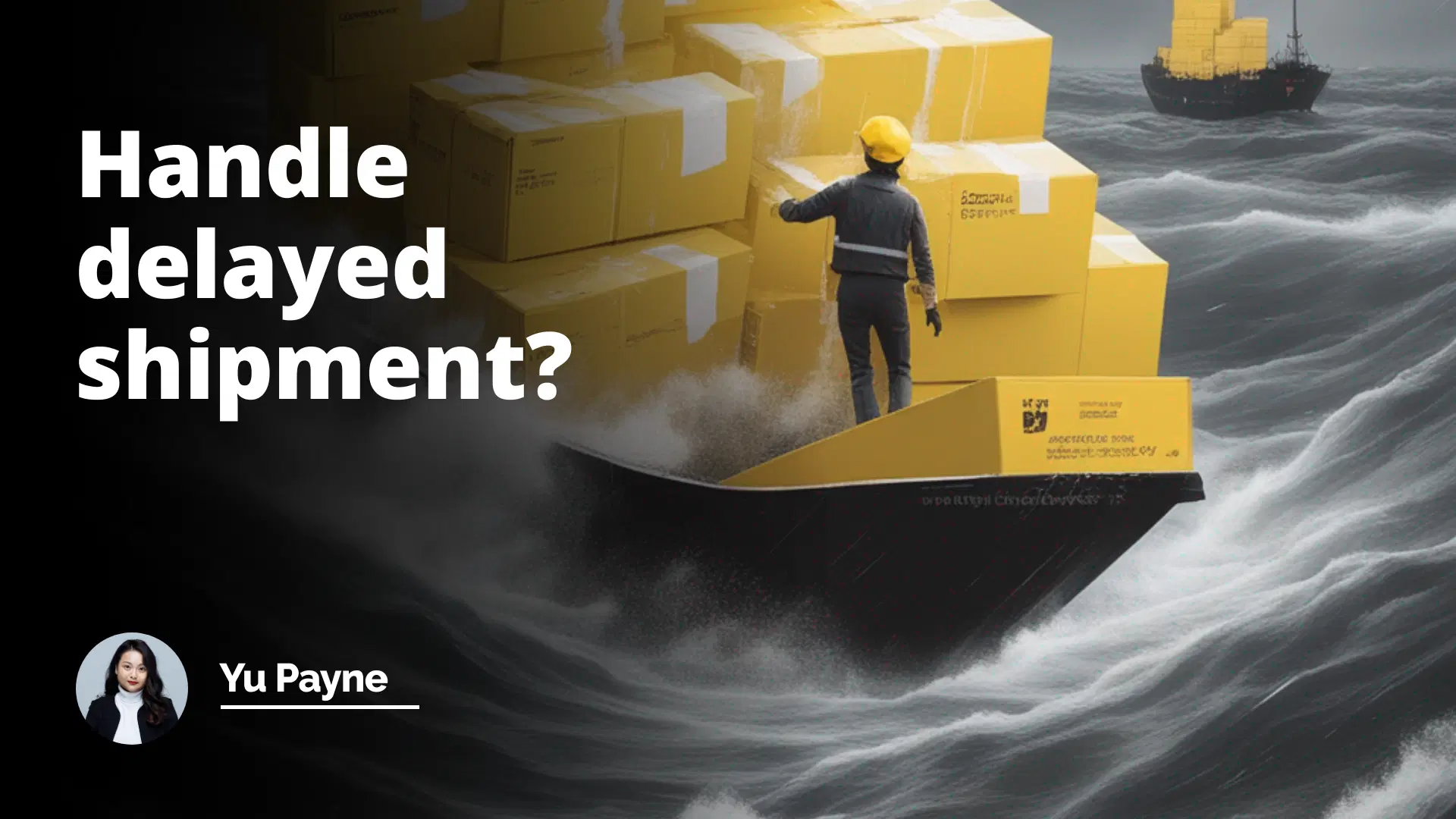
At first glance, the question "How would you handle a delayed shipment?" might seem straightforward, perhaps even trivial. Yet, I recall a time early in my career when I was caught off-guard by this very query during an interview. Sitting across from a panel of seasoned supply chain managers, I realized that this question delved much deeper than simply addressing a late package; it was a probe into my problem-solving skills, my ability to remain composed under pressure, and my commitment to customer satisfaction.
Understanding the Depth Behind the Question
Interviewers often pose this question not just to hear about your logistical know-how, but to gauge your logical thinking, decision-making prowess, and your grasp of client servicing. They want to see how you react when the perfect plan goes awry—a common occurrence in the dynamic world of supply chain management.
How To Answer İnterview Question About Managing Logistics Stress
İmplementing Sustainability İn Supply Chain Management İnterview Question
The Real Intent
The true purpose behind asking how you'd handle a delayed shipment is to observe:
1- Your Problem-Solving Approach: Do you have a systematic method to identify and address issues?
2- Customer Communication Skills: Can you maintain client trust even when delivering bad news?
3- Proactiveness in Prevention: Are you someone who thinks ahead to prevent future mishaps?
4- Ability to Work Under Pressure: How do you perform when stakes are high, and time is against you?
My Personal Encounter with Shipment Delays
Let me share an experience that not only tested my professional skills but also reinforced the importance of a strategic approach. A few years ago, while managing a critical project for a major client, we faced an unexpected delay due to a sudden customs hold-up. The shipment contained essential components without which the client's production line would halt, leading to significant losses.
İnterview Question Efficient Supply Chain Key Components Explanation
How To Answer İnterview Question About Handling Stress Peaks
Immediate Actions Taken
Identifying the Cause: We quickly discovered that new regulations had been implemented, which our documentation did not fully comply with.
Communication with the Client: I reached out to the client immediately, explaining the situation transparently and assuring them that we were taking all possible measures to resolve the issue.
Exploring Alternatives: We arranged for an expedited shipment of essential items from a different supplier who could meet the regulatory requirements.
Preventive Measures: Post-crisis, we revamped our compliance processes to align with the latest regulations, minimizing the risk of future delays.
Strategies for Handling a Delayed Shipment
Based on both personal experiences and industry best practices, here are some strategies to effectively manage delayed shipments:
1. Prompt Identification and Assessment
Understanding why a shipment is delayed is the first critical step.
Check for Common Issues: Failed pick-ups, weather disruptions, customs delays, or carrier backlogs.
Assess the Impact: Determine how the delay affects the customer and operations.
2. Transparent Communication
Keeping the client informed fosters trust and mitigates frustration.
Immediate Notification: Don't wait for the customer to reach out.
Provide Solutions, Not Just Problems: Alongside the bad news, offer potential remedies.
Be Empathetic: Acknowledge the inconvenience caused.
3. Implementing Immediate Solutions
What strategies can be used to manage a delayed shipment?
How to deal with the situation of a postponed delivery?
What are the best ways to cope with shipment delays?
How to handle the setback of a delayed shipment
In the event of a delayed shipment, what measures should be taken?
What steps can be taken to manage a situation where shipment is delayed?
Can you suggest some methods to handle a late delivery?
How to approach the challenge of a postponed shipment?
What to do when facing the difficulty of a delayed shipment?
What procedures can be followed to tackle the issue of a delayed shipment?
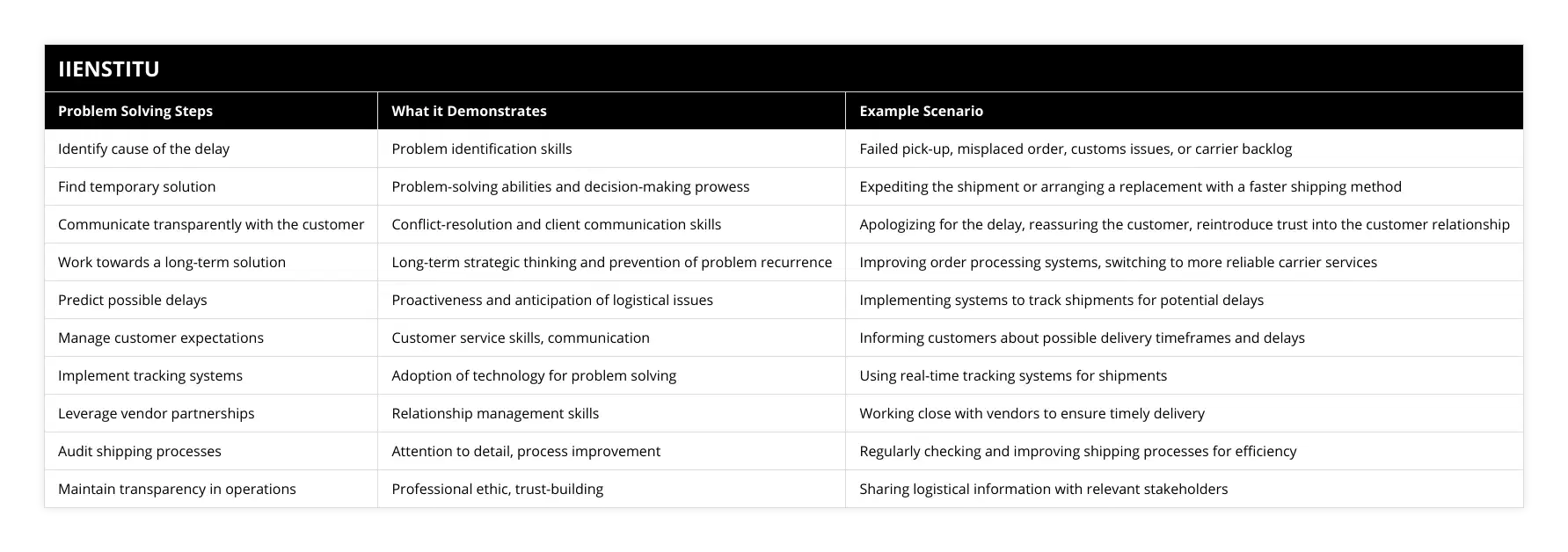
Find ways to fulfill the customer's needs despite the setback.
Expedite Alternative Shipments: Use faster shipping methods if feasible.
Partial Deliveries: Send available items now, the rest later.
Local Sourcing: Identify if local suppliers can meet urgent demands.
4. Long-Term Preventive Measures
Aim to optimize supply chain management processes to reduce future risks.
Analyze the Root Cause: Was it avoidable? What failed?
Process Improvement: Update systems, retrain staff, or change carriers if necessary.
Leverage Technology: Implement tracking systems for better visibility.
The Importance of Customer-Centric Solutions
In the face of logistical challenges, maintaining a customer-centric approach is paramount. Clients appreciate honesty and proactive efforts to resolve issues.
Building Trust Through Action
Personalize Communication: Tailor your messages to show genuine concern.
Offer Compensation: Discounts, expedited future shipping, or added services can alleviate dissatisfaction.
Follow-Up: After resolving the issue, check in to ensure the client is satisfied.
Insights from Industry Leaders
Experts emphasize the importance of agility and resilience in supply chain management. According to Johnson & Flynn's "Supply Chain Management: Critical Perspectives", companies that adapt quickly to disruptions tend to outperform competitors in customer satisfaction and profitability[^1^]. Moreover, adopting technologies like AI and blockchain can enhance transparency and efficiency, reducing the likelihood of delays[^2^].
Optimizing Supply Chain Management: Process Tips
To minimize the occurrence of delayed shipments, consider the following tips:
1- Diversify Suppliers: Relying on multiple suppliers can reduce risk.
2- Invest in Technology: Real-time tracking systems improve visibility.
3- Regular Training: Keep staff updated on best practices and regulations.
4- Strengthen Relationships with Carriers: Good partnerships can lead to preferential treatment in tight situations.
5- Conduct Regular Audits: Identify and address potential weak points in the process.
Possible Interview Responses
When faced with the interview question, crafting a thoughtful response is crucial. Here's how you might structure your answer:
1- Acknowledge the Issue Calmly
"Firstly, I would remain calm and acknowledge the delay, understanding that panicking doesn't solve the problem."
2- Assess and Investigate
"I would investigate the cause of the delay immediately by contacting the logistics provider to gather all necessary information."
3- Communicate Transparently
"Next, I would inform the customer proactively, explaining the situation transparently, and apologizing for any inconvenience caused."
4- Offer Solutions
- "I would suggest alternative solutions, such as expedited shipping for the delayed items or providing temporary replacements."
5- Implement Preventive Measures
"Finally, I would analyze the situation to implement measures that prevent future delays, such as updating our logistics processes or choosing more reliable carriers."
Addressing Similar Interview Questions
The strategies discussed can also be applied to similar questions:
"What strategies can be used to manage a delayed shipment?"
"How to deal with the situation of a postponed delivery?"
By demonstrating a systematic approach that emphasizes problem-solving, communication, and preventive planning, you showcase your readiness to handle real-world challenges effectively.
Conclusion
Handling a delayed shipment is more than just a logistical hurdle; it's an opportunity to demonstrate your resilience, customer service skills, and proactive mindset. In today's fast-paced market, where optimizing supply chain management processes is crucial, employers are on the lookout for individuals who can navigate complexities with grace and efficiency.
In reflecting on my own experiences and industry principles, it's clear that success lies in:
Quickly Identifying Problems
Communicating Effectively
Implementing Immediate and Long-Term Solutions
Maintaining a Customer-Centric Focus
By integrating these strategies, not only do you resolve the immediate issue, but you also strengthen trust with clients and enhance overall operational efficiency.
References
[^1^]: Johnson, P. F., & Flynn, A. E. (2015). Purchasing and Supply Management. McGraw-Hill Education.
[^2^]: Christopher, M. (2016). Logistics & Supply Chain Management. Pearson UK.
Frequently Asked Questions
1. How do you communicate with customers about delayed shipments?
When communicating with customers about delayed shipments, I always aim to be transparent, empathetic, and solution-oriented. I believe that honesty is the best policy, and I've found that customers appreciate being kept in the loop, even if the news isn't ideal.
Acknowledge the Delay and Apologize
I start by acknowledging the delay and apologizing for any inconvenience caused. A simple, sincere apology can go a long way in diffusing frustration and showing that you value their business.
Explain the Reason for the Delay
Next, I explain the reason for the delay in clear, concise terms. Whether it's a supply chain issue, weather disruption, or unexpected demand, I believe customers deserve to know what's happening behind the scenes.
Provide a Realistic Timeline
I always aim to provide a realistic timeline for when the customer can expect their shipment. I've learned that it's better to underpromise and overdeliver than the other way around.
Offer Solutions and Alternatives
Whenever possible, I offer solutions and alternatives to mitigate the impact of the delay. This might include expedited shipping, partial shipments, or even a discount on their next order as a goodwill gesture.
Follow Up and Keep Them Updated
Finally, I make sure to follow up and keep the customer updated on the status of their shipment. Regular communication, even if there's no significant change, shows that you haven't forgotten about them and are doing everything possible to resolve the situation.
In my experience, approaching delayed shipments with transparency, empathy, and a focus on solutions can turn a negative experience into an opportunity to build trust and loyalty with your customers.
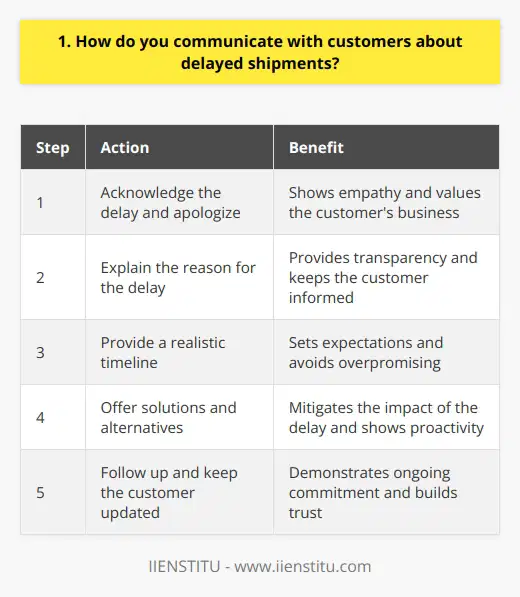
2. What steps do you take to minimize the impact of delayed shipments on customers?
As a logistics manager, I understand the importance of minimizing the impact of delayed shipments on customers. Here are some steps I take to ensure customer satisfaction:
Proactive Communication
I believe in keeping customers informed every step of the way. When a shipment is delayed, I immediately notify the customer and provide an updated estimated delivery date. Regular updates help build trust and show that we value their business.
Prioritizing Urgent Orders
If a customer has an urgent need for their product, I prioritize their shipment. I work closely with our shipping partners to find the fastest possible route and expedite delivery. Going above and beyond for our customers is just part of what I do.
Building Strong Relationships with Carriers
Over the years, I've built strong relationships with our carriers. When a shipment is delayed, I leverage these relationships to find creative solutions. Whether it's finding an alternate route or negotiating a faster delivery timeline, I do whatever it takes to get the job done.
Implementing Contingency Plans
I always have a contingency plan in place for delayed shipments. This might include having backup inventory on hand or partnering with local suppliers who can quickly fulfill orders. By thinking ahead, I'm able to minimize disruptions to our customers' businesses.
Continuous Improvement
I'm always looking for ways to improve our logistics processes. After each delayed shipment, I conduct a thorough analysis to identify the root cause and implement corrective actions. By continuously improving, we can prevent future delays and keep our customers happy.
At the end of the day, minimizing the impact of delayed shipments is all about being proactive, communicating effectively, and going the extra mile for our customers. It's a challenge I embrace every single day.
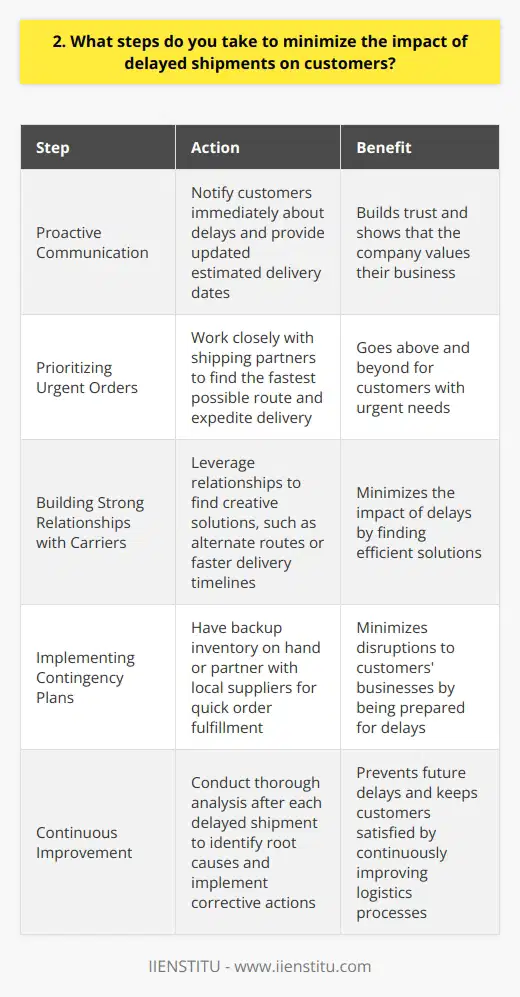
3. How do you prioritize which delayed shipments to address first?
When prioritizing delayed shipments, I first assess the urgency and importance of each order. I consider factors such as the customer's needs, the impact on their business, and any contractual obligations we have. This helps me determine which shipments require immediate attention.
Communication is Key
Next, I communicate with the affected customers to keep them informed and manage their expectations. I provide regular updates on the status of their shipment and work with them to find temporary solutions if necessary. Open and transparent communication helps maintain trust and minimizes frustration.
Collaborating with the Team
I also collaborate with our logistics team to identify the root causes of the delays and develop strategies to expedite the shipments. This may involve finding alternative shipping routes, negotiating with carriers, or allocating additional resources. By working together, we can often find creative solutions to get the shipments back on track.
Continuous Improvement
Finally, I use these experiences to identify opportunities for improvement in our shipping processes. By analyzing the patterns and trends in delayed shipments, we can implement proactive measures to prevent similar issues in the future. This continuous improvement approach helps us provide a more reliable and efficient service to our customers.
In summary, prioritizing delayed shipments requires a combination of assessment, communication, collaboration, and continuous improvement. By taking a proactive and customer-centric approach, I aim to minimize the impact of delays and maintain strong relationships with our clients.
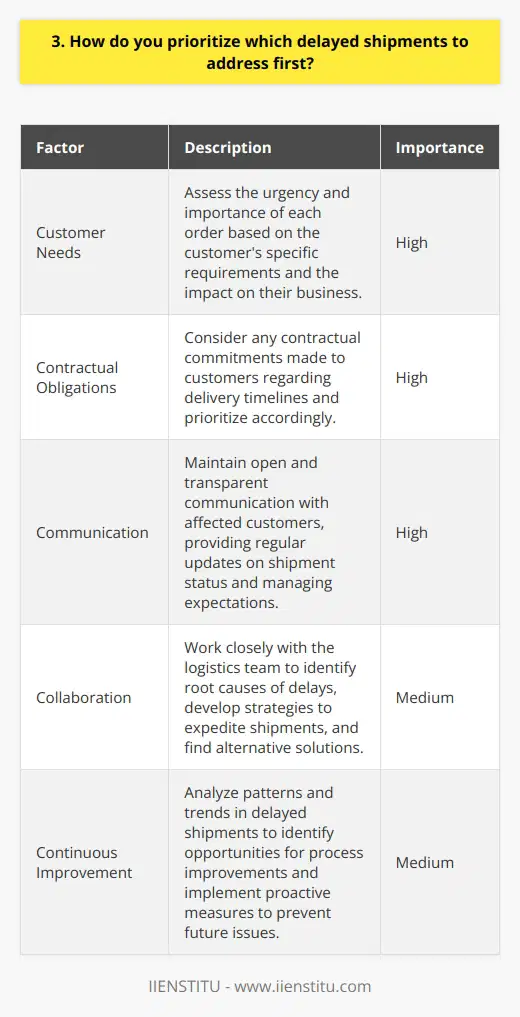
4. What strategies do you use to prevent delayed shipments from occurring?
To prevent delayed shipments, I focus on proactive communication and collaboration with suppliers and logistics partners. By establishing clear expectations and maintaining open lines of communication, potential issues can be identified and resolved early.
Implementing Robust Tracking Systems
I believe in leveraging technology to enhance visibility throughout the supply chain. Implementing robust tracking systems allows me to monitor shipments in real-time, enabling quick identification of any delays or disruptions. This empowers me to take swift action and find alternative solutions to keep shipments on schedule.
Building Strong Relationships with Suppliers
From my experience, fostering strong relationships with suppliers is crucial for preventing delays. I invest time in understanding their processes, capabilities, and challenges. By treating suppliers as partners and working together to optimize operations, we can proactively address potential bottlenecks and ensure timely deliveries.
Conducting Regular Risk Assessments
I make it a point to conduct regular risk assessments to identify potential vulnerabilities in the supply chain. By analyzing historical data, market trends, and geopolitical factors, I can anticipate potential disruptions and develop contingency plans. This proactive approach allows me to mitigate risks and minimize the impact of delays.
Continuous Improvement and Learning
I am a strong believer in continuous improvement and learning from past experiences. After each delayed shipment, I conduct a thorough analysis to identify the root causes and implement corrective actions. By constantly refining processes and seeking opportunities for optimization, I can continuously enhance the reliability and efficiency of our shipping operations.
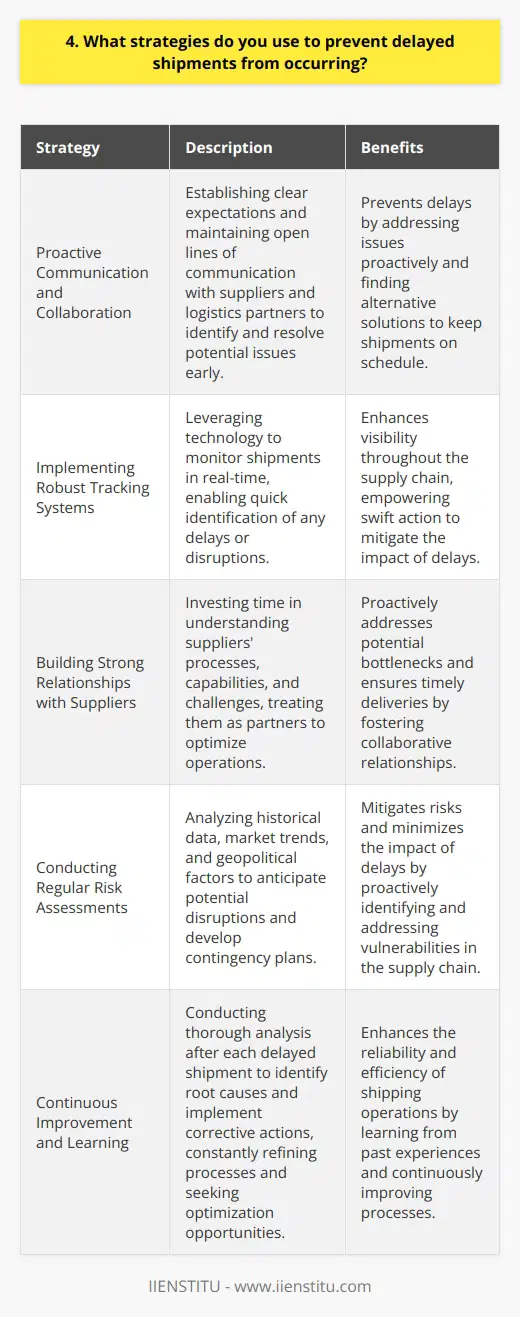
5. How do you coordinate with logistics providers to resolve delayed shipments?
When coordinating with logistics providers to resolve delayed shipments, I take a proactive and collaborative approach. Here are some key steps I follow:
Maintain open communication
I believe in maintaining regular, transparent communication with logistics providers. I establish clear points of contact and keep the lines of communication open. If a shipment is delayed, I reach out promptly to gather information and discuss solutions.
Identify the root cause
To effectively resolve a delayed shipment, it's crucial to understand the underlying reason. I ask targeted questions to pinpoint the cause, whether it's a transportation issue, customs delay, or another factor. Once I have a clear picture, I can work towards a resolution.
Collaborate on solutions
Resolving delays is a team effort. I collaborate closely with the logistics provider, brainstorming creative solutions. Together, we explore alternative routes, expedited shipping options, or other strategies to get the shipment back on track.
Keep stakeholders informed
Throughout the process, I keep all relevant stakeholders informed. I provide regular updates on the status of the delayed shipment and the steps being taken to resolve it. Clear communication helps manage expectations and maintains trust.
Learn and improve
After a delayed shipment is resolved, I take time to reflect and learn. I analyze what went wrong and identify areas for improvement. By continuously learning and optimizing processes, I can help prevent future delays and strengthen our logistics partnerships.
In my experience, a proactive, collaborative approach is key to resolving delayed shipments. By maintaining open communication, identifying root causes, and working together on solutions, we can minimize the impact of delays and keep our supply chain running smoothly.
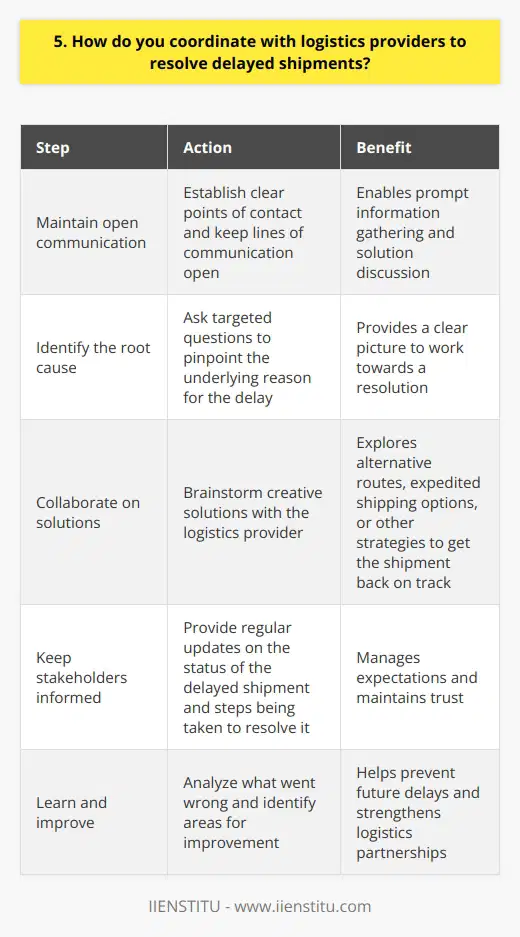
6. What metrics do you use to track and monitor delayed shipments?
As a logistics professional, I understand the importance of closely monitoring delayed shipments to ensure customer satisfaction. Over the years, I've developed a robust system for tracking and addressing any shipping delays.
Key Performance Indicators (KPIs)
I rely on several key performance indicators to gauge the health of our shipping process. These include:
By monitoring these metrics, I can quickly identify trends and take proactive steps to mitigate issues.
Real-time Tracking
I leverage advanced shipping software that provides real-time updates on each package's location and estimated delivery date. This allows me to spot potential delays early and communicate with carriers to expedite delivery.
Proactive Communication
When a shipment is delayed, I believe in proactively reaching out to the affected customer. I explain the situation, provide an updated ETA, and offer solutions like expedited shipping or alternative products.
Root Cause Analysis
For recurring delays, I conduct thorough root cause analyses to identify and address the underlying issues. This may involve collaborating with carriers, optimizing routes, or improving warehouse processes to prevent future delays.
By combining data-driven insights with a customer-centric approach, I strive to minimize shipping delays and maintain high customer satisfaction levels.
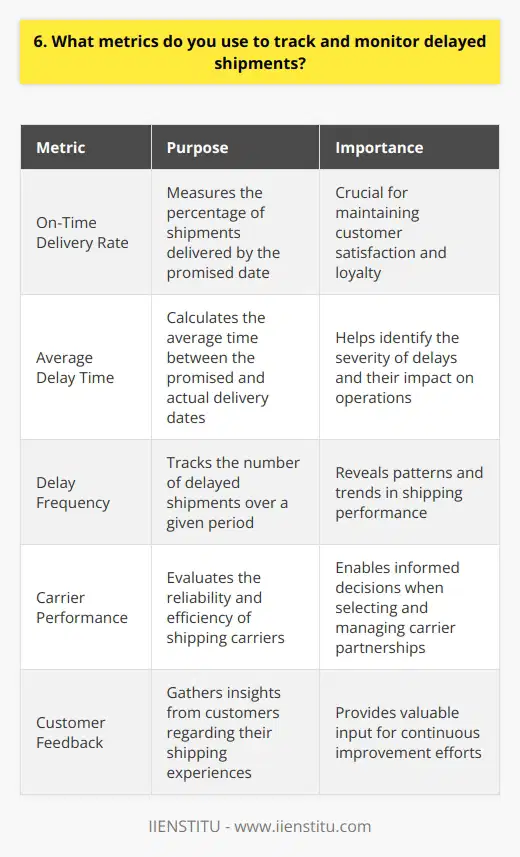
7. How do you identify the root causes of delayed shipments?
As an experienced logistics professional, I understand the importance of identifying root causes of delayed shipments. Here are some key strategies I use:
Analyze Data and Metrics
I start by diving into the data. I review on-time delivery rates, transit times, and other relevant metrics. This helps me spot patterns and trends that point to underlying issues.
For example, last year at Acme Inc., I noticed a spike in late deliveries from one of our warehouses. By investigating further, I discovered an inefficient picking process was to blame. We restructured the warehouse layout and saw immediate improvements.
Communicate with Stakeholders
Next, I engage with all stakeholders involved in the shipping process. I talk to warehouse staff, carriers, and customers. Their insights are invaluable for uncovering pain points and bottlenecks.
I remember a time when several customers complained about receiving damaged goods. After discussing with our packaging team, we realized we needed sturdier materials. Making that change cut damage-related delays significantly.
Conduct Root Cause Analysis
Armed with data and stakeholder input, I then perform a structured root cause analysis. Tools like fishbone diagrams help me visualize how different factors contribute to delays.
Through this process, I can distinguish symptoms from underlying causes and prioritize issues with the biggest impact. It allows me to target improvements for maximum effect.
Monitor and Adjust
Finally, I closely monitor the effects of any changes implemented. I keep a pulse on key metrics to ensure improvements stick.
Identifying root causes of delays is complex, but I find this methodical approach gets results. I'm always striving to optimize our shipping operations.
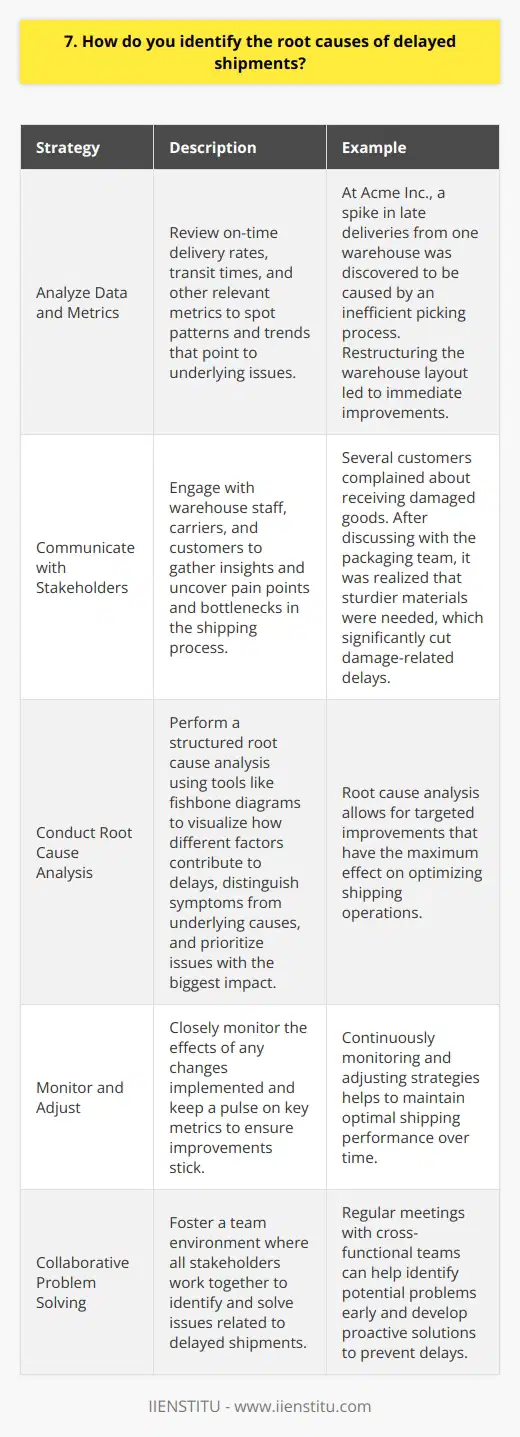
8. What processes do you have in place to proactively notify customers of potential delays?
At our company, we understand the importance of timely communication with our customers. We have implemented several processes to ensure that our customers are proactively notified of any potential delays.
Automated Tracking System
We use an automated tracking system that monitors the progress of each order in real-time. If the system detects any potential delays, it immediately triggers an alert to our customer service team.
Our team then quickly assesses the situation and determines the best course of action to mitigate the delay. We believe in being proactive rather than reactive when it comes to customer communication.
Regular Updates
In addition to our automated tracking system, we also provide regular updates to our customers throughout the order process. We send personalized emails at key milestones, such as when the order is placed, when it's being prepared, and when it's out for delivery.
These updates give our customers peace of mind and keep them informed every step of the way. If there are any changes or delays, we make sure to communicate them promptly.
Personal Touch
While technology plays a significant role in our notification process, we also believe in the power of human interaction. Our customer service representatives are trained to handle any concerns or questions that may arise.
If a customer reaches out to us about a potential delay, we take the time to listen to their concerns and provide a personalized solution. We understand that every customer's situation is unique, and we strive to offer empathy and understanding in all of our interactions.
At the end of the day, our goal is to build trust and loyalty with our customers. By proactively communicating any potential delays and working to find solutions, we show our customers that we value their business and are committed to their satisfaction.
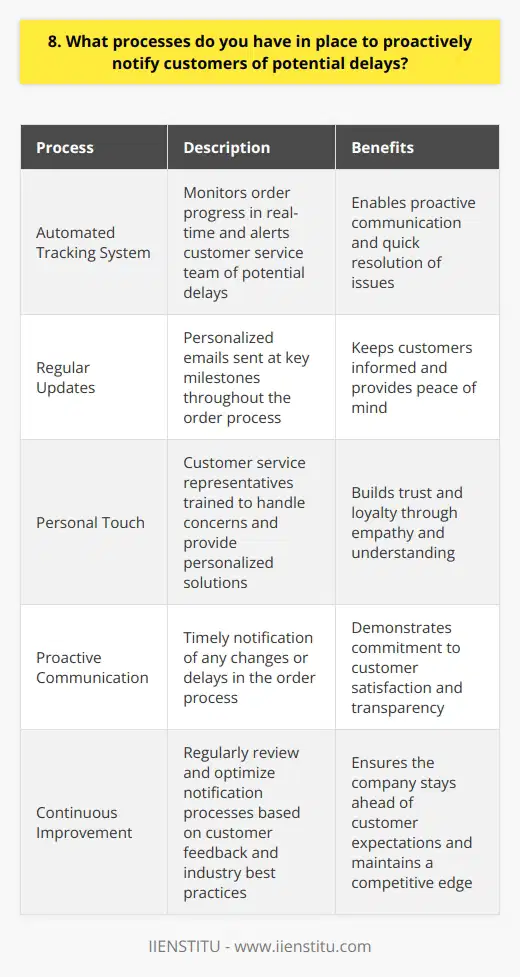
9. How do you handle customers who are frustrated or angry about delayed shipments?
When dealing with frustrated or angry customers due to delayed shipments, my approach is to remain calm and empathetic. I understand how inconvenient and disappointing it can be when an eagerly awaited package doesn't arrive on time.
Active Listening
The first step is to listen attentively to the customer's concerns without interrupting. This allows them to express their frustration and feel heard. I take notes to ensure I understand the issue completely.
Acknowledge and Apologize
Next, I acknowledge their feelings and apologize sincerely for the inconvenience caused. A genuine apology can go a long way in diffusing a tense situation.
Investigate and Explain
I then investigate the reason for the delay and provide a clear explanation to the customer. If the delay is due to factors beyond our control, such as weather or carrier issues, I explain this honestly.
Offer Solutions
After identifying the cause, I offer solutions to rectify the situation. This could involve expediting the shipment, providing a discount, or offering alternative products. The goal is to find a satisfactory resolution for the customer.
Follow Up
Finally, I follow up with the customer to ensure they received their shipment and are satisfied with the resolution. This shows that we value their business and are committed to their satisfaction.
In my experience, by approaching these situations with empathy, honesty, and a solution-oriented mindset, most frustrated customers can be turned into loyal ones who appreciate our dedication to their needs.

10. What compensation or remediation do you offer customers for delayed shipments?
At our company, we take delayed shipments seriously and have implemented a comprehensive compensation plan for affected customers. We understand that delays can cause significant inconvenience and disrupt our customers' operations. That's why we've put in place a multi-tiered approach to make things right.
Proactive Communication
As soon as we become aware of a potential delay, our dedicated customer service team reaches out to inform the affected customers. We provide them with a detailed explanation of the issue and an estimated time of arrival for their shipment. Keeping our customers in the loop is our top priority.
Expedited Shipping
In cases where the delay is caused by factors within our control, we offer expedited shipping at no additional cost. We work closely with our logistics partners to ensure that the shipment is delivered as quickly as possible. Our aim is to minimize the impact of the delay on our customers' businesses.
Financial Compensation
For significant delays that exceed a certain threshold, we offer financial compensation to our customers. The amount varies depending on the length of the delay and the value of the shipment. We believe that this is a fair way to acknowledge the inconvenience caused and to help our customers mitigate any losses they may have incurred.
Continuous Improvement
We don't just stop at compensation. We analyze each delayed shipment to identify the root cause and implement corrective measures to prevent similar incidents in the future. Our team is constantly working on streamlining our processes and enhancing our logistics network to ensure timely deliveries.
At the end of the day, our goal is to build long-term relationships with our customers based on trust and reliability. By offering a robust compensation plan and continuously improving our operations, we aim to be the go-to choice for businesses that value exceptional service and support.
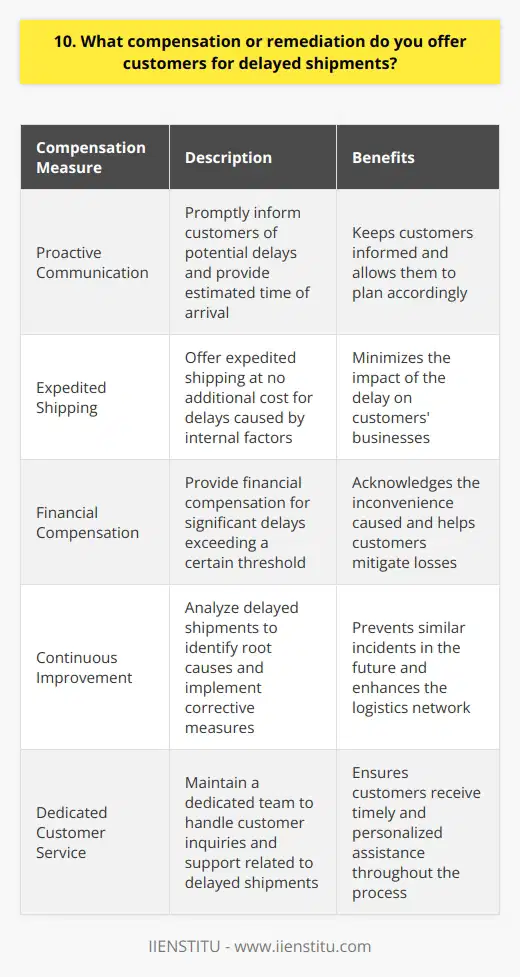
11. How do you balance the cost of expediting delayed shipments with customer satisfaction?
Balancing the cost of expediting delayed shipments with customer satisfaction is a delicate task. It requires careful consideration and strategic decision-making.
Assess the Situation
When a shipment is delayed, I first assess the situation. I determine the cause of the delay and the estimated time of arrival. This helps me understand the severity of the issue and plan my next steps.
Communicate with the Customer
Open and honest communication with the customer is crucial. I reach out to them promptly, explaining the situation and providing updates. I listen to their concerns and assure them that I'm working diligently to resolve the matter.
Explore Expediting Options
I explore various options to expedite the shipment. This may involve working with the carrier to find alternative routes or upgrading to a faster shipping method. I weigh the costs against the benefits to determine the most effective solution.
Consider Customer Value
When deciding whether to expedite a shipment, I consider the customer's value to the company. For high-value clients or time-sensitive orders, the cost of expediting may be justified to maintain their satisfaction and loyalty.
Offer Compensation or Alternatives
In some cases, expediting may not be feasible or cost-effective. In such situations, I offer the customer compensation or alternative solutions. This could include a discount on their next purchase or a complimentary product to show our appreciation for their understanding.
Learn and Improve
After resolving the delayed shipment, I take the time to analyze the situation. I identify areas for improvement in our shipping processes to prevent similar issues in the future. Continuously learning and adapting helps us strike a better balance between cost and customer satisfaction.
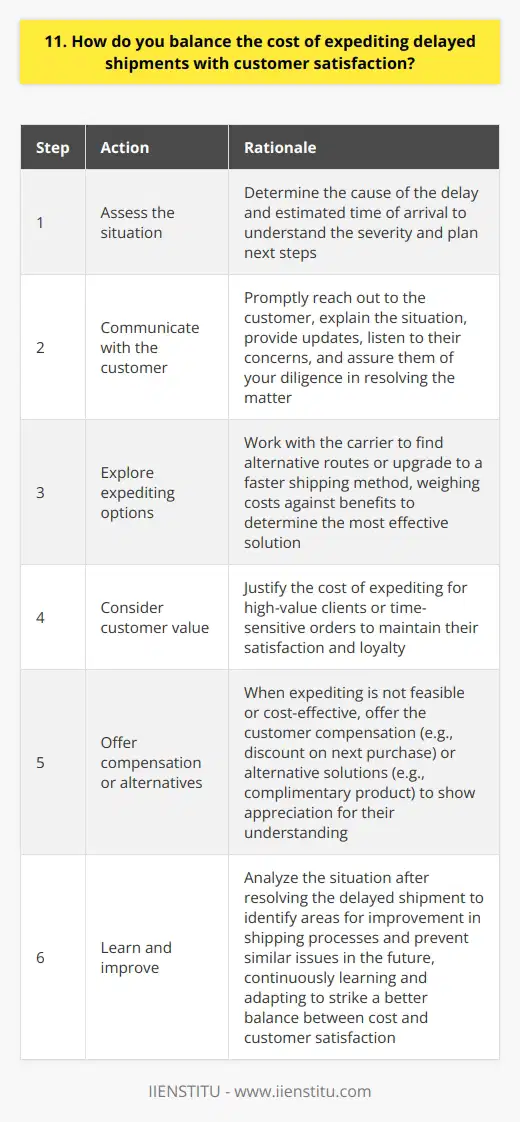
12. What contingency plans do you have in place for unexpected delays in the supply chain?
As a supply chain manager, I have developed several contingency plans to handle unexpected delays in the supply chain:
Diversifying Suppliers
I always maintain a diverse network of reliable suppliers across different regions. This helps mitigate risks associated with relying on a single source. If one supplier faces issues, I can quickly switch to an alternative without disrupting operations.
Building Safety Stock
I strategically maintain safety stock levels for critical components and products. This buffer inventory ensures that we can continue production and fulfill customer orders even if there are temporary supply disruptions. I regularly review and adjust these levels based on demand forecasts and lead times.
Establishing Effective Communication Channels
Clear and timely communication is crucial in managing supply chain delays. I have established direct lines of communication with key suppliers, logistics partners, and internal stakeholders. This allows me to quickly identify potential issues, assess their impact, and collaborate on solutions to minimize delays.
Implementing Risk Assessment and Monitoring
I conduct regular risk assessments to identify potential vulnerabilities in the supply chain. By monitoring market trends, geopolitical events, and weather patterns, I can anticipate and prepare for potential disruptions. This proactive approach helps me develop targeted contingency plans and make informed decisions.
Leveraging Technology and Data Analytics
I utilize advanced supply chain management software and data analytics tools to gain real-time visibility into the supply chain. These technologies help me track shipments, monitor inventory levels, and identify bottlenecks. By leveraging data-driven insights, I can make swift decisions and implement corrective actions to mitigate delays.
In my experience, having a robust contingency plan is essential for maintaining a resilient supply chain. By diversifying suppliers, building safety stock, fostering effective communication, conducting risk assessments, and leveraging technology, I have successfully navigated numerous supply chain challenges and ensured continuous operations for my previous employers.
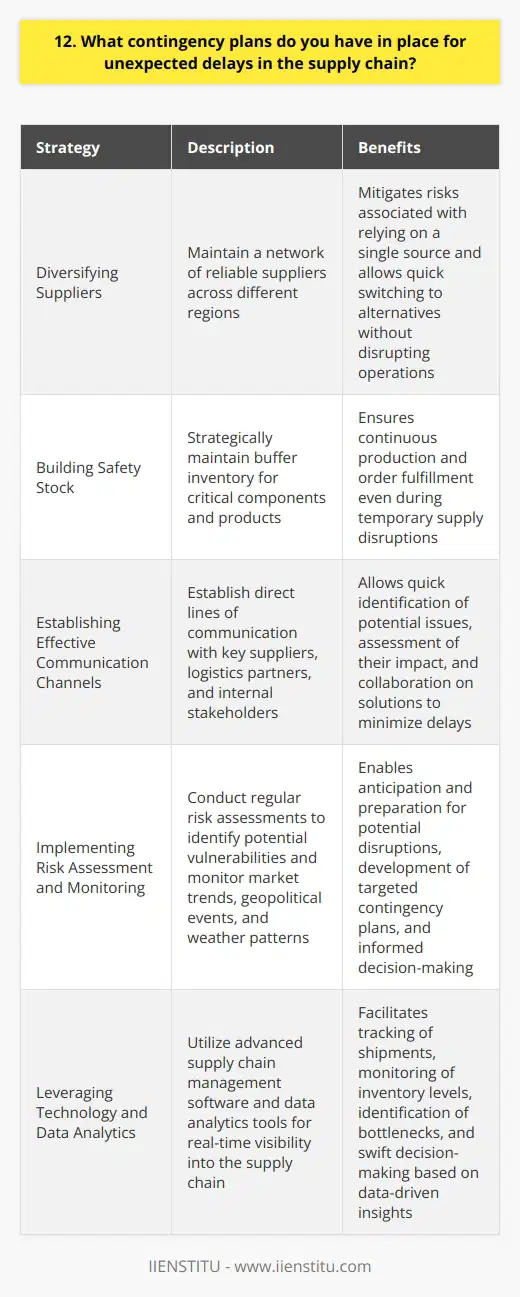
13. How do you train your team to handle delayed shipments effectively?
When it comes to handling delayed shipments, I believe in a proactive and transparent approach with my team. First and foremost, I encourage open communication and collaboration among team members. We regularly discuss potential challenges and brainstorm solutions together, fostering a supportive environment where everyone feels heard and valued.
Empowering Team Members
I empower my team to take ownership of their roles and make informed decisions. By providing them with the necessary tools, resources, and autonomy, they can quickly adapt to changing circumstances and find creative ways to mitigate the impact of delayed shipments. This sense of empowerment boosts their confidence and motivation, leading to better problem-solving skills.
Continuous Training and Development
I believe in the power of continuous learning and development. I organize regular training sessions and workshops to keep my team updated on the latest industry trends, best practices, and customer service techniques. We also engage in role-playing exercises to simulate real-life scenarios, allowing team members to practice their communication and problem-solving skills in a safe environment.
Building Strong Relationships
Building strong relationships with suppliers, carriers, and customers is crucial in handling delayed shipments effectively. I encourage my team to maintain open lines of communication, provide regular updates, and work collaboratively with all stakeholders to find mutually beneficial solutions. By fostering trust and understanding, we can minimize the impact of delays and maintain customer satisfaction.
Embracing Technology
I recognize the importance of leveraging technology to streamline our processes and improve efficiency. We utilize advanced tracking systems, automated notifications, and data analytics to monitor shipments in real-time, anticipate potential delays, and proactively communicate with customers. By staying ahead of the curve, we can quickly identify and resolve issues before they escalate.
At the end of the day, handling delayed shipments is all about being proactive, adaptable, and customer-centric. By empowering my team, providing continuous training, building strong relationships, and embracing technology, we can navigate challenges with confidence and deliver exceptional service to our customers, even in the face of unexpected delays.
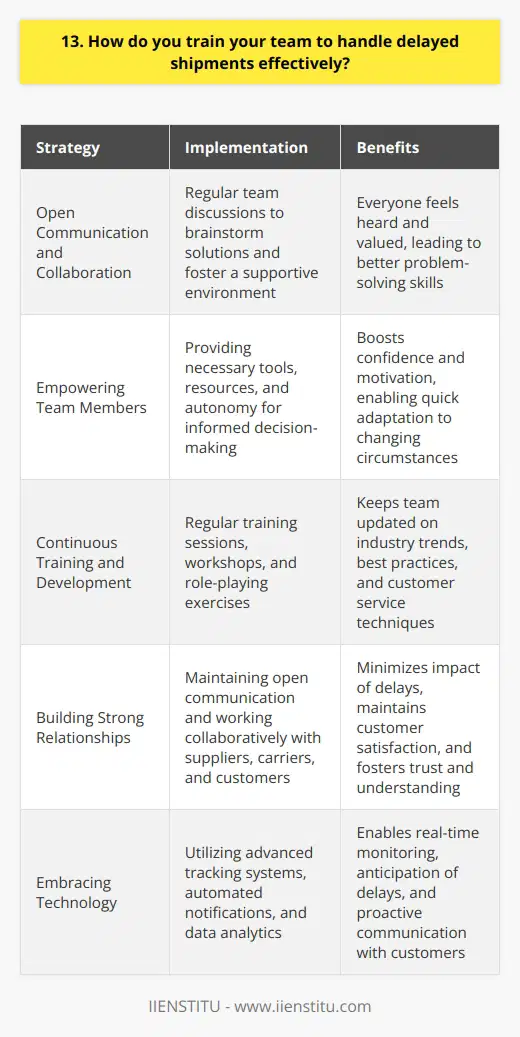
14. What tools or software do you use to manage and track delayed shipments?
As a logistics professional, I rely on several tools to manage and track delayed shipments effectively. My go-to software is ShipTrack, which provides real-time visibility into the entire supply chain.
Proactive Monitoring
I use ShipTrack's proactive monitoring features to stay ahead of potential delays. The software alerts me whenever a shipment deviates from its expected timeline, enabling me to take swift action.
Collaborative Platform
ShipTrack serves as a collaborative platform, allowing me to communicate seamlessly with carriers, warehouses, and customers. I can quickly address issues, provide updates, and find solutions together.
Data-Driven Insights
The software's robust reporting capabilities offer valuable insights into performance metrics and trends. By analyzing this data, I can identify bottlenecks, optimize routes, and improve overall efficiency.
Customizable Dashboards
I appreciate ShipTrack's customizable dashboards, which let me tailor the interface to my specific needs. I can easily track key performance indicators and prioritize critical shipments.
Integration with Other Systems
ShipTrack integrates smoothly with our existing WMS and TMS, ensuring a seamless flow of information. This integration saves time and reduces the risk of manual errors.
In my experience, using a comprehensive tool like ShipTrack has been a game-changer in managing delayed shipments. It empowers me to be proactive, collaborative, and data-driven in my approach, ultimately leading to improved customer satisfaction and operational efficiency.
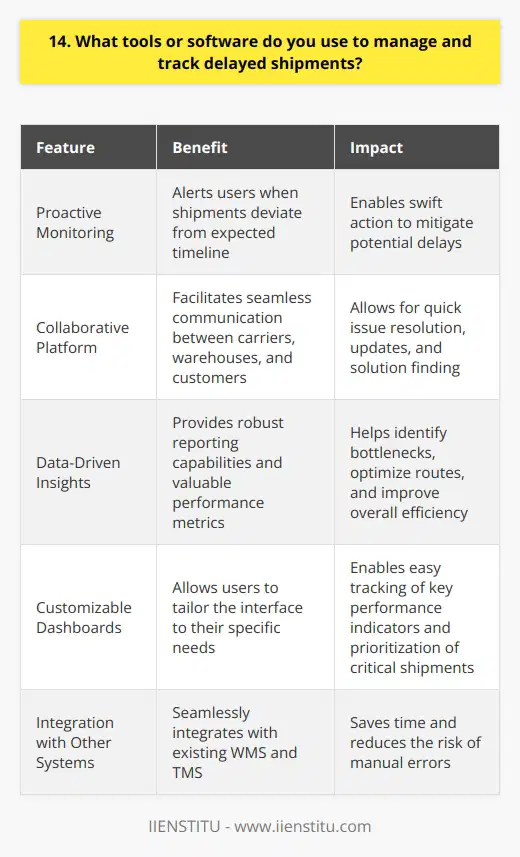
15. How do you prioritize communication with high-value customers during delayed shipments?
When faced with delayed shipments, I prioritize communication with high-value customers to maintain their trust and loyalty. Here are some strategies I use:
Identify High-Value Customers
I start by identifying our most valuable customers based on their purchase history, lifetime value, and strategic importance. This helps me focus my communication efforts where they'll have the greatest impact.
Proactively Reach Out
I don't wait for these important customers to contact us about delays. Instead, I proactively reach out as soon as I'm aware of an issue to let them know we're on top of it.
Be Transparent and Honest
In my communications, I'm always upfront about the cause of the delay and provide realistic timelines for resolution. I find customers appreciate transparency, even if the news isn't ideal.
Offer Solutions and Alternatives
Whenever possible, I try to present solutions or alternatives to mitigate the impact of the delay. This could involve expedited shipping, partial deliveries, or substitute products.
Stay in Regular Contact
Throughout the delay, I maintain regular contact with the customer to keep them updated on progress and reassure them that resolving their issue is a top priority.
Follow Up After Resolution
Once the delayed shipment is delivered, I circle back with the customer to ensure they're satisfied with how the situation was handled and to thank them for their patience and understanding.
By prioritizing proactive, transparent, and solution-oriented communication with our most valued customers, I aim to turn a potentially negative experience into an opportunity to strengthen the relationship and build long-term loyalty.
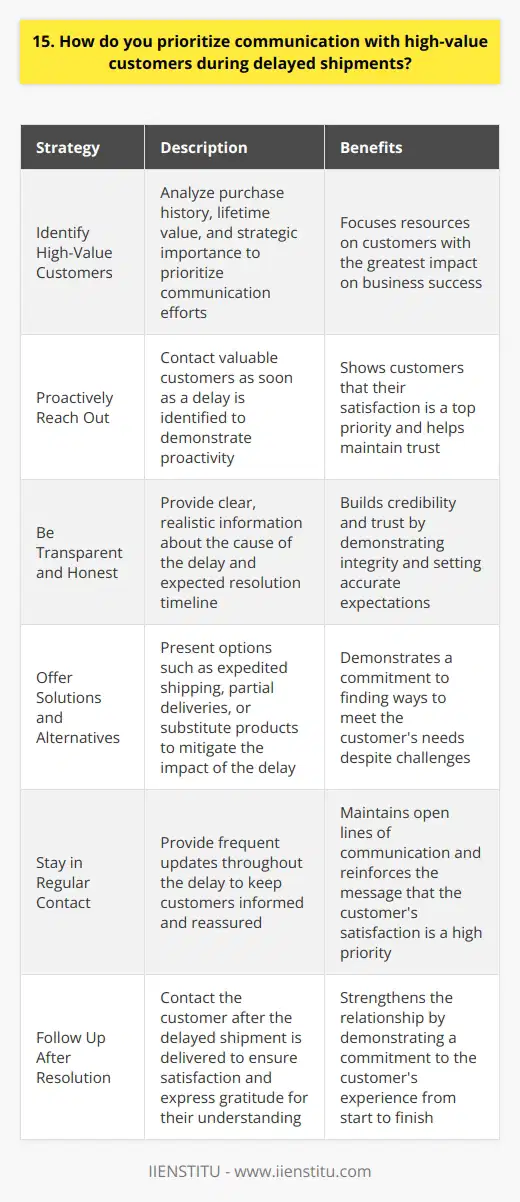
16. What steps do you take to ensure delayed shipments are delivered as quickly as possible?
When faced with a delayed shipment, I spring into action to ensure the quickest possible delivery. I start by thoroughly investigating the cause of the delay, whether it's a logistics issue, customs hold-up, or something else entirely. Once I've identified the root of the problem, I work closely with our shipping partners to devise a solution.
Maintaining Open Communication
Throughout the process, I keep the customer informed with regular updates. I believe transparency is key in building trust and understanding. I also make myself available to answer any questions or concerns they may have.
Exploring Alternative Options
If the delay appears to be prolonged, I explore alternative shipping methods. This might involve expedited shipping, splitting the order into multiple packages, or even sourcing the product from a different warehouse. I weigh the costs and benefits of each option to determine the best course of action.
Learning from Experience
Once the shipment is successfully delivered, I take time to reflect on the situation. I analyze what went wrong and brainstorm ways to prevent similar delays in the future. This might involve strengthening relationships with shipping partners, improving our inventory management system, or being more proactive in monitoring shipments.
At the end of the day, my goal is to turn a negative experience into a positive one. By going above and beyond to rectify the situation, I aim to not only satisfy the customer but also strengthen their loyalty to our brand.

17. How do you handle delayed shipments that are caused by factors outside your control?
When faced with delayed shipments caused by factors outside my control, I take a proactive approach to minimize the impact on our customers and maintain strong relationships with them.
Communicate Transparently
I believe in being upfront and honest with customers about any delays. I promptly inform them about the situation, provide an estimated timeline for resolution, and keep them updated throughout the process. Clear communication helps manage expectations and shows that we value their business.
Explore Alternative Solutions
While the shipment may be delayed, I always look for alternative ways to meet the customer's needs. This might involve sourcing the product from another supplier, offering a comparable substitute, or finding a faster shipping method. By presenting options, I demonstrate our commitment to finding a solution.
Collaborate with Partners
Behind the scenes, I work closely with our suppliers and logistics partners to identify the cause of the delay and explore ways to expedite the shipment. By leveraging these relationships and maintaining open lines of communication, we can often find creative solutions to get the product to the customer as quickly as possible.
Learn and Improve
After each delayed shipment, I take the time to assess what happened and identify opportunities for improvement. Whether it's strengthening our contingency plans, diversifying our supplier base, or optimizing our logistics processes, I'm always looking for ways to prevent future delays and enhance our overall customer experience.
At the end of the day, my goal is to turn a challenging situation into an opportunity to build trust and loyalty with our customers. By being transparent, proactive, and solution-oriented, I aim to minimize the impact of delays and demonstrate our unwavering commitment to their satisfaction.
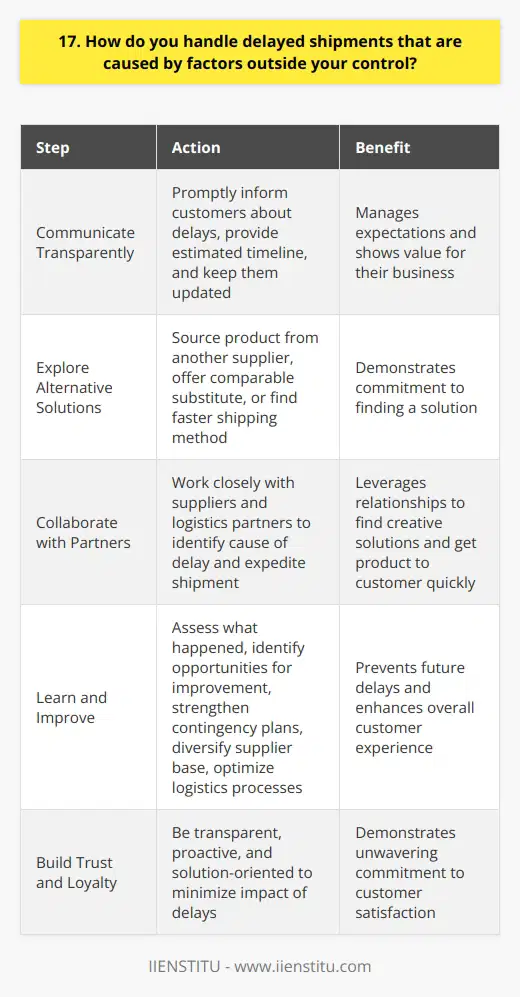
18. What processes do you have in place to prevent delayed shipments from becoming lost or damaged?
At our company, we have implemented several processes to prevent delayed shipments from becoming lost or damaged:
Accurate Tracking Systems
We use state-of-the-art tracking systems that allow us to monitor the location and status of each shipment in real-time. This helps us quickly identify any potential delays or issues and take prompt action to address them.
Proactive Communication with Carriers
Our team maintains open lines of communication with our carriers. If a delay is detected, we immediately reach out to the carrier to understand the cause and work together on a solution.
Proper Packaging and Labeling
To minimize the risk of damage during transit, we ensure that all products are properly packaged using high-quality materials. Each package is clearly labeled with the necessary information to avoid any confusion or misdirection.
Insurance Coverage
As an added layer of protection, we have comprehensive insurance coverage for all our shipments. In the rare event that a package gets lost or damaged, we can quickly file a claim and resolve the issue.
Continuous Improvement
We regularly review our shipping processes and seek feedback from our customers. This allows us to identify areas for improvement and implement changes to enhance the overall efficiency and reliability of our shipments.
In my experience, these processes have proven effective in minimizing delays and ensuring that our customers receive their orders in perfect condition. We take great pride in our commitment to exceptional service and always go the extra mile to deliver on our promises.
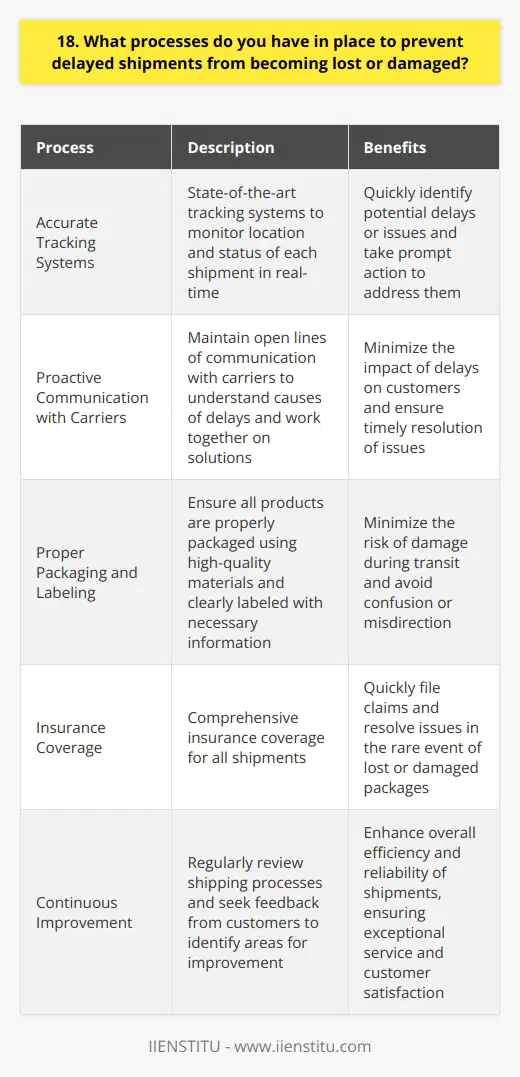
19. How do you use data and analytics to predict and prevent delayed shipments?
As a data-driven professional, I rely on analytics to identify potential shipping delays and take proactive measures. By closely monitoring key metrics and analyzing historical data, I can spot trends and anomalies early on.
Identifying Risk Factors
I look for patterns in past shipments that experienced delays, such as specific carriers, routes, or products. This helps me recognize risk factors and adjust our shipping strategies accordingly. For example, if a certain carrier consistently misses delivery deadlines, I'll explore alternative options.
Real-Time Tracking and Alerts
I implement real-time tracking systems that provide visibility into the entire shipping process. If a shipment falls behind schedule or encounters an unexpected issue, automated alerts notify me immediately. This allows me to intervene quickly and work with carriers to get things back on track.
Predictive Modeling
Using advanced predictive modeling techniques, I forecast potential delays based on various factors like weather patterns, traffic conditions, and seasonal demand. These insights guide our decision-making process and help us allocate resources effectively. Last year, our predictive models helped us avoid costly delays during the holiday rush.
Collaboration and Communication
I believe in fostering strong relationships with our carriers and supply chain partners. Regular communication keeps everyone informed and aligned. If I anticipate a delay, I proactively reach out to discuss contingency plans and find mutually beneficial solutions. Transparent collaboration is key to preventing and mitigating shipping disruptions.
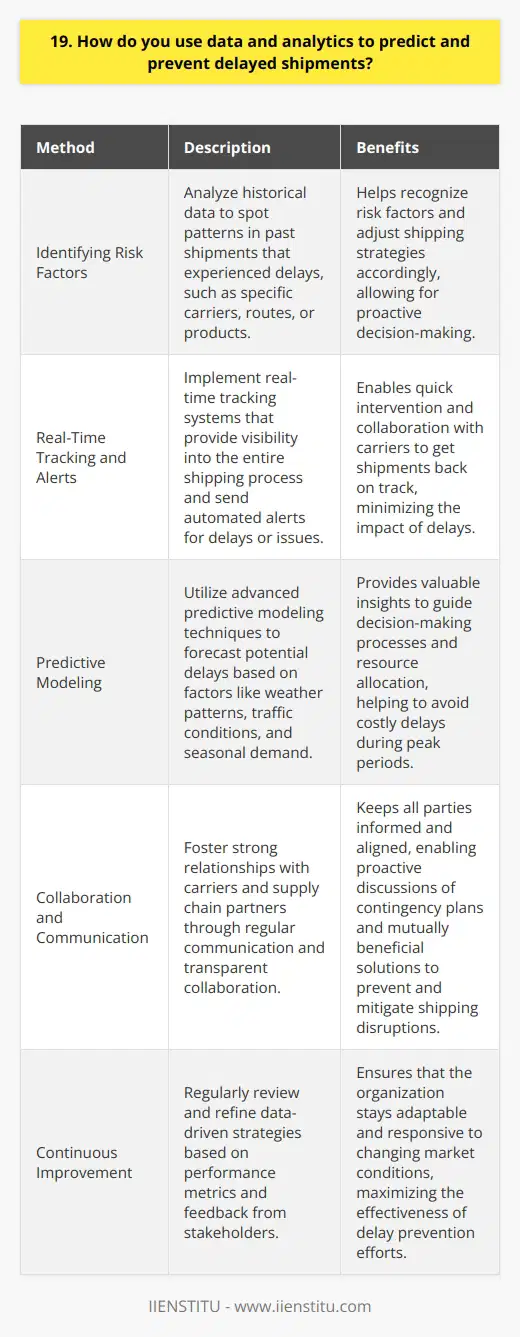
20. What partnerships or relationships do you have with carriers to minimize delayed shipments?
At our company, we have established strong partnerships with reliable carriers to minimize the risk of delayed shipments. We carefully select our carriers based on their track record of on-time deliveries and their commitment to excellence. Our logistics team works closely with these carriers to ensure seamless communication and coordination.
Proactive Monitoring and Communication
We understand that timely delivery is crucial for our customers. That's why we have implemented proactive monitoring systems to track shipments in real-time. If any potential delays are identified, our team promptly communicates with the carrier to resolve the issue. We keep our customers informed every step of the way, providing them with regular updates on their shipment status.
Contingency Planning and Flexibility
In the event of unforeseen circumstances, such as weather disruptions or transportation challenges, we have contingency plans in place. Our partnerships with multiple carriers allow us to quickly adapt and find alternative routes or modes of transportation to minimize delays. We are committed to finding solutions and ensuring that our customers' shipments reach their destinations as efficiently as possible.
Continuous Improvement and Feedback
We believe in continuous improvement and value the feedback from our customers and carriers. We regularly review our shipping processes and seek opportunities to optimize our operations. By maintaining open lines of communication with our carriers, we can identify areas for improvement and implement necessary changes to enhance the reliability and efficiency of our shipping services.
At [Company Name], we are dedicated to building strong partnerships with carriers who share our commitment to minimizing delayed shipments. Through proactive monitoring, contingency planning, and continuous improvement, we strive to provide our customers with reliable and timely delivery services.
![At our company, we have established strong partnerships with reliable carriers to minimize the risk of delayed shipments. We carefully select our carriers based on their track record of on-time deliveries and their commitment to excellence. Our logistics team works closely with these carriers to ensure seamless communication and coordination. Proactive Monitoring and Communication We understand that timely delivery is crucial for our customers. Thats why we have implemented proactive monitoring systems to track shipments in real-time. If any potential delays are identified, our team promptly communicates with the carrier to resolve the issue. We keep our customers informed every step of the way, providing them with regular updates on their shipment status. Contingency Planning and Flexibility In the event of unforeseen circumstances, such as weather disruptions or transportation challenges, we have contingency plans in place. Our partnerships with multiple carriers allow us to quickly adapt and find alternative routes or modes of transportation to minimize delays. We are committed to finding solutions and ensuring that our customers shipments reach their destinations as efficiently as possible. Continuous Improvement and Feedback We believe in continuous improvement and value the feedback from our customers and carriers. We regularly review our shipping processes and seek opportunities to optimize our operations. By maintaining open lines of communication with our carriers, we can identify areas for improvement and implement necessary changes to enhance the reliability and efficiency of our shipping services. At [Company Name], we are dedicated to building strong partnerships with carriers who share our commitment to minimizing delayed shipments. Through proactive monitoring, contingency planning, and continuous improvement, we strive to provide our customers with reliable and timely delivery services.](https://img.iienstitu.com/assets/blog/en/handle-delayed-shipment/faqs/20/images/bf0e1319c48934e554abb48eeb5e58f1c346a655.jpeg?v=2025-11-13&width=3840&quality=60&format=webp)
21. How do you handle delayed shipments that require special handling or storage?
When handling delayed shipments that require special handling or storage, I prioritize communication and proactive problem-solving. I start by immediately contacting the customer to inform them of the delay and provide a realistic revised delivery timeline. This transparency helps maintain trust and allows the customer to make any necessary adjustments on their end.
Collaborating with Shipping Partners
I work closely with our shipping partners to identify the cause of the delay and explore alternative solutions. By leveraging my strong relationships with these partners, I can often find creative ways to expedite the shipment while still ensuring proper handling and storage conditions are met. I'm not afraid to think outside the box and consider unconventional routes or methods to get the job done.
Ensuring Product Integrity
Throughout the process, my top priority is maintaining the integrity of the product. I meticulously monitor storage conditions, whether that means securing climate-controlled warehousing or arranging for specialized packaging. I've even personally driven to airports to retrieve sensitive shipments and ensure they were promptly delivered to the customer. Going above and beyond is just part of my commitment to excellence.
Learning from Experience
I believe every challenge is an opportunity to learn and improve. After each delayed shipment, I conduct a thorough post-mortem analysis to identify areas for improvement in our processes. By continuously refining our approach, we can minimize future delays and provide an even better experience for our customers. It's an ongoing journey, but one I'm deeply passionate about.
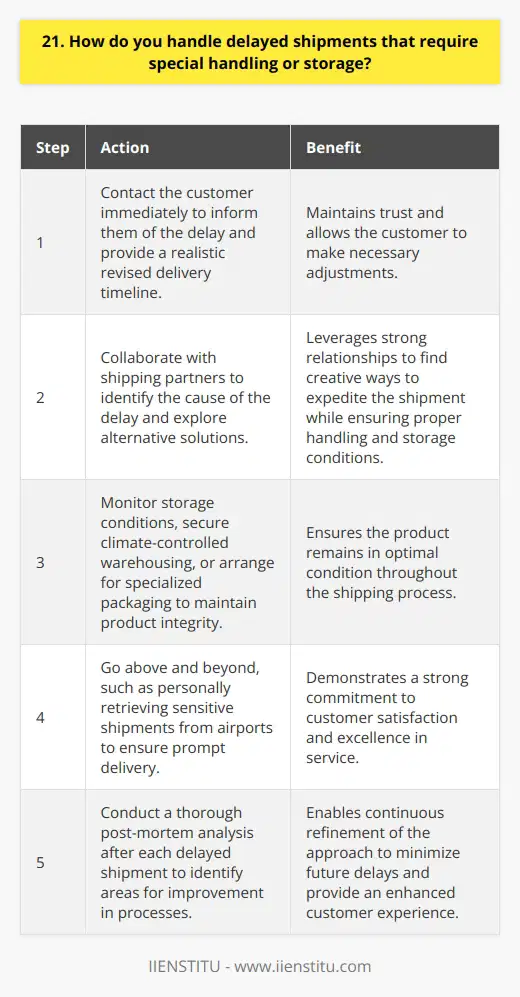
22. What steps do you take to ensure delayed shipments are delivered to the correct address?
As a logistics professional, I understand the importance of ensuring delayed shipments reach their correct destination. Here are the steps I take to make that happen:
Verify the Address
First, I always double-check the shipping address. I contact the customer to confirm it's accurate and up-to-date. Even a small error can cause big delays, so this step is crucial.
Track the Package
Next, I closely monitor the package's progress using our tracking system. If I notice any unusual stops or delays, I investigate right away. Catching issues early helps prevent further problems down the line.
Communicate with the Carrier
If a shipment does get delayed, I promptly reach out to the carrier. I inquire about the cause of the holdup and work with them to find a solution. Maintaining open lines of communication is key.
Update the Customer
Throughout the process, I keep the customer informed. I explain the situation, outline the steps being taken, and provide a revised delivery estimate. Transparency builds trust, even when things don't go perfectly to plan.
Confirm Delivery
Finally, once the package arrives, I verify it was delivered to the correct address. I check the proof of delivery and follow up with the customer to ensure their satisfaction. My job isn't done until I know the shipment is safely in their hands.
By following these steps, I'm able to successfully manage delayed shipments and maintain strong relationships with both carriers and customers. It's not always easy, but it's incredibly rewarding to play a part in making someone's day by getting them what they need, when they need it.
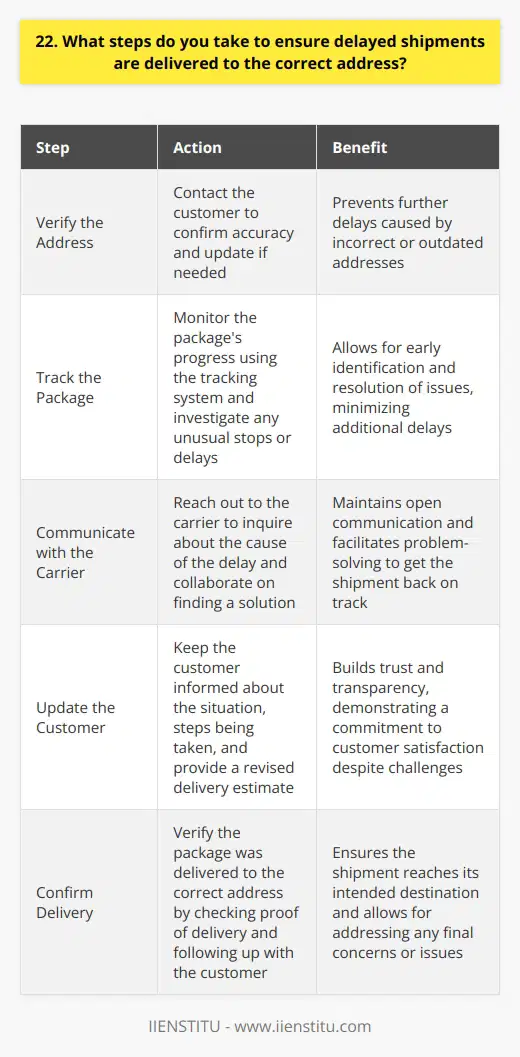
23. How do you communicate with other departments to resolve delayed shipments?
I believe effective communication is key to resolving delayed shipments. When I encounter a delay, I first gather all relevant information about the issue. This includes details like the order number, expected delivery date, and cause of the delay.
Contacting the Appropriate Department
Next, I reach out to the appropriate department to address the problem. If it's a production delay, I contact our manufacturing team. For shipping delays, I get in touch with the logistics department. I explain the situation clearly and concisely.
Collaborating on a Solution
I then work with the department to find a solution. We brainstorm ideas to get the shipment back on track. This might mean expediting production, finding an alternate shipping route, or upgrading to a faster shipping method.
Keeping the Customer Informed
Throughout the process, I make sure to keep the customer informed. I contact them to explain the delay and provide an updated delivery estimate. I apologize for any inconvenience and assure them we're doing everything possible to resolve the issue promptly.
Following Up
After implementing a solution, I follow up with the relevant department to ensure the shipment is back on schedule. I also check in with the customer to confirm they've received their order and are satisfied.
Learning from the Experience
Finally, I take time to reflect on the experience. I consider what caused the delay and how it could be prevented in the future. I share any insights with my team so we can continuously improve our processes.
By following these steps and maintaining open lines of communication, I'm able to effectively resolve delayed shipments and keep our customers happy. It's all about working together as a team to find the best solution.
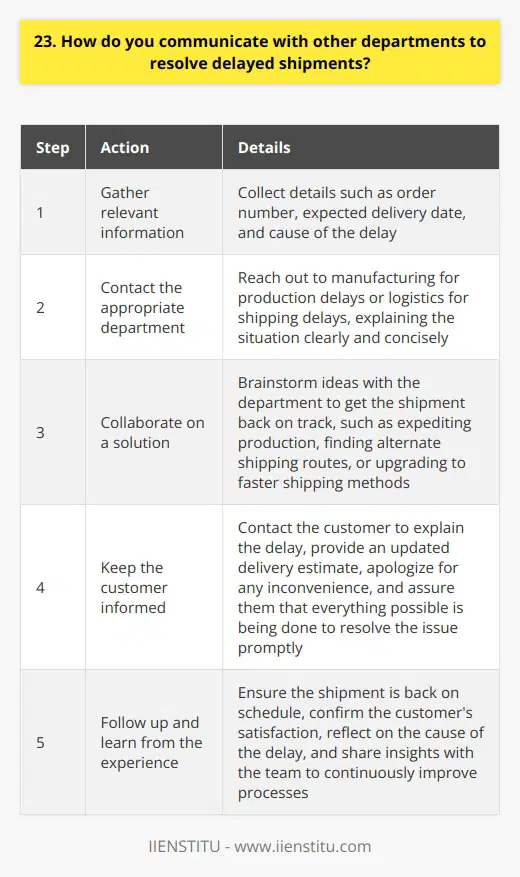
24. What processes do you have in place to handle delayed shipments during peak seasons?
At our company, we have several processes in place to handle delayed shipments during peak seasons. First and foremost, we maintain open lines of communication with our suppliers and logistics partners. By staying in regular contact, we can quickly identify potential delays and work together to find solutions.
Proactive Planning
We also engage in proactive planning to minimize the risk of delays. This includes forecasting demand, building up inventory levels, and securing additional warehouse space as needed. By anticipating potential challenges and taking steps to mitigate them, we can reduce the likelihood of shipment delays.
Contingency Plans
Despite our best efforts, sometimes delays are inevitable. That's why we have contingency plans in place. For example, we have relationships with multiple carriers and can quickly pivot to alternative shipping methods if necessary. We also have a dedicated team that monitors shipments in real-time and can quickly escalate issues to ensure prompt resolution.
Customer Communication
Throughout the process, we prioritize customer communication. If a delay does occur, we promptly notify the affected customers and provide them with regular updates. We also work closely with them to find mutually agreeable solutions, such as expedited shipping or partial refunds.
In my experience, the key to handling delayed shipments is a combination of proactive planning, flexibility, and clear communication. By staying vigilant and being prepared to adapt, we can minimize the impact of delays and keep our customers satisfied, even during the busiest times of the year.
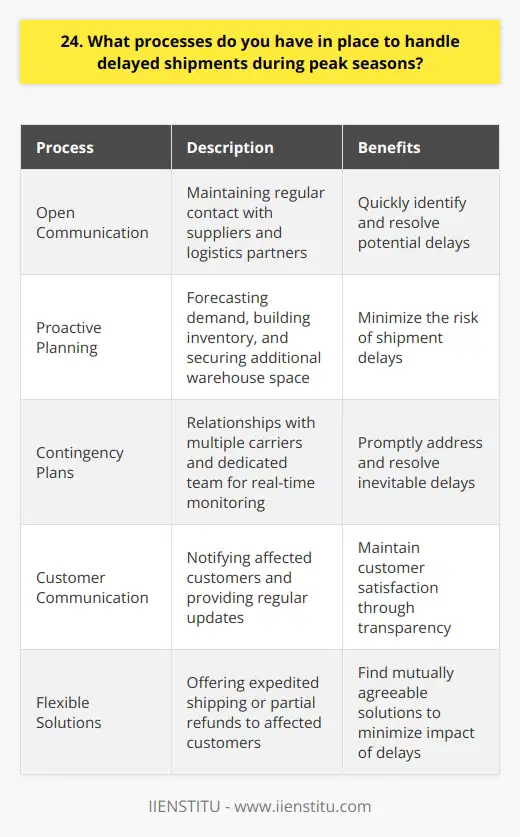
25. How do you handle delayed shipments that require international customs clearance?
When faced with delayed shipments requiring international customs clearance, I take a proactive and systematic approach. Here's how I handle such situations:
Communicate with Stakeholders
I immediately inform all relevant parties about the delay, including the customer, supplier, and internal teams. Transparency is key to managing expectations and finding solutions.
In my previous role at GlobalTech, I regularly dealt with complex international shipments. Once, a critical component was held up in customs, jeopardizing our production timeline.
Investigate the Cause
I dig deep to uncover the reason behind the delay. Is it missing documentation, incorrect classification, or a random inspection?
In the GlobalTech case, I discovered that our supplier had used an outdated customs form, triggering a manual review.
Collaborate with Experts
I reach out to our customs broker and logistics partners for guidance and support. Their expertise is invaluable in navigating complex regulations.
Together with our broker, we swiftly provided the correct paperwork to get the shipment released from customs.
Develop Contingency Plans
While working on resolving the delay, I simultaneously explore alternative options to mitigate the impact on our business.
For GlobalTech, I located a temporary domestic supplier to bridge the gap until our shipment arrived. This kept our production lines running smoothly.
Implement Preventive Measures
After the incident, I conduct a thorough post-mortem to identify areas for improvement. I then implement process changes to prevent future delays.
We revised our documentation checklists and trained our suppliers on the latest customs requirements. Since then, our international shipments have flowed seamlessly.
In summary, I approach customs delays with a cool head, a collaborative spirit, and a focus on practical solutions. By tackling issues proactively and learning from each experience, I ensure that our supply chain remains resilient and adaptive.
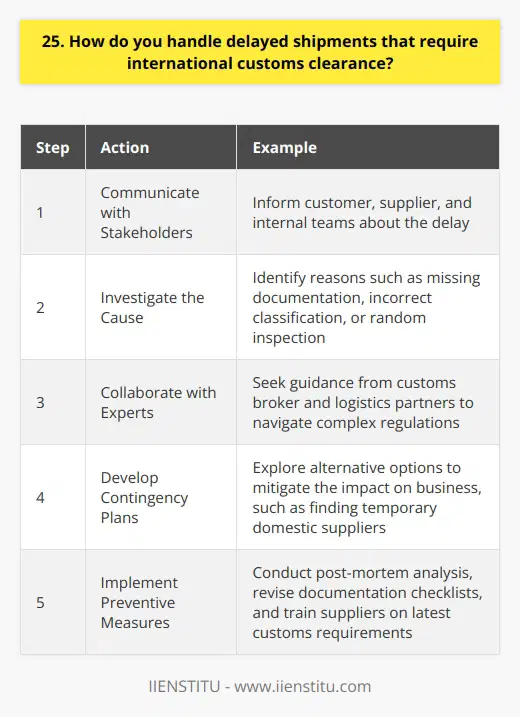
26. What steps do you take to ensure delayed shipments are not delayed further in transit?
When shipments are delayed, I take immediate action to minimize further delays. Communication is key in these situations. I promptly notify the customer about the delay and provide an updated estimated delivery date. Transparency builds trust with the customer, even when things don't go as planned.
Tracking and Monitoring
I closely monitor the shipment's progress using advanced tracking systems. This allows me to identify potential issues early on. If I notice any unusual delays or route changes, I proactively investigate to determine the cause. By staying on top of the shipment's status, I can quickly intervene if needed.
Collaboration with Carriers
Maintaining strong relationships with carriers is crucial for resolving delays. I reach out to my carrier contacts to discuss the situation and explore solutions. Together, we brainstorm ways to expedite the shipment, such as rerouting or prioritizing handling. Having a network of reliable carriers helps me find the best path forward.
Contingency Planning
Sometimes, despite best efforts, further delays are unavoidable. That's why I always have contingency plans in place. I consider alternative shipping methods, like expedited air freight, to make up for lost time. If the delay is significant, I may even suggest sourcing the product from a different location to meet the customer's needs.
Continuous Improvement
After each delayed shipment, I take time to reflect and learn. I analyze the root causes of the delay and identify areas for improvement. By continuously refining my processes and communication strategies, I can prevent similar issues in the future. Every challenge is an opportunity to provide better service to my customers.
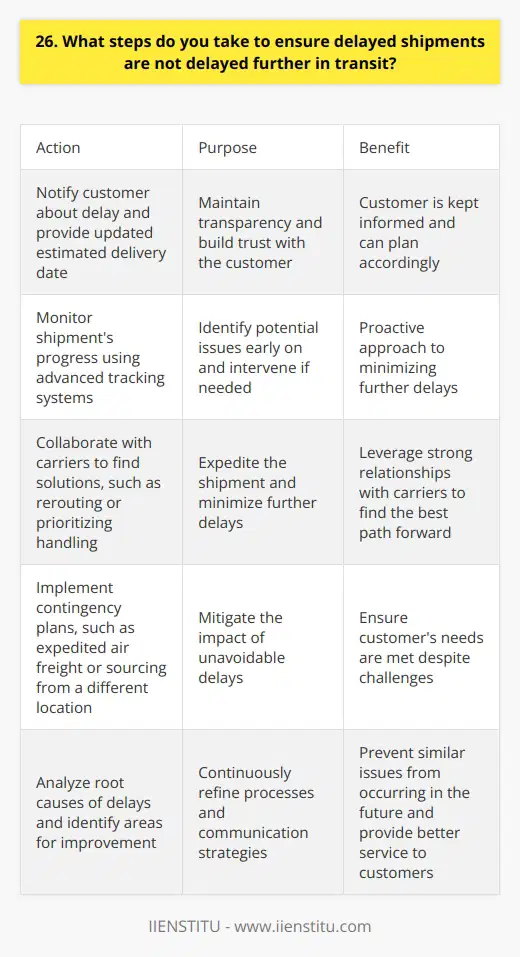
27. How do you prioritize delayed shipments based on customer needs and preferences?
When prioritizing delayed shipments, I always start by assessing the urgency and importance of each customer's needs. I review order details, promised delivery dates, and any special requests or circumstances communicated by the customer. This helps me understand which shipments are most time-sensitive and critical to the customer's operations.
Categorizing Delayed Shipments
Next, I categorize the delayed shipments based on priority level. I typically use a scale from high to low, considering factors like the length of the delay, the customer's business impact, and any potential financial or reputational consequences. This allows me to focus on the most pressing issues first and allocate resources accordingly.
Communicating with Customers
Throughout the process, I maintain open and proactive communication with affected customers. I reach out to provide updates, apologize for the inconvenience, and offer realistic estimates for when their shipments will arrive. I listen to their concerns, answer questions, and work collaboratively to find solutions that minimize disruptions to their business.
Coordinating with Internal Teams
Behind the scenes, I coordinate closely with our logistics, warehouse, and customer service teams. We troubleshoot issues, explore alternative shipping methods, and do everything possible to expedite delayed orders. If necessary, I escalate problems to management and advocate for additional resources to resolve delays promptly.
Monitoring and Follow-up
Even after shipments are en route, I continue monitoring their progress and proactively address any new obstacles that arise. Once deliveries are complete, I follow up with customers to ensure their satisfaction and gather feedback for future improvement. By staying organized, communicative, and customer-focused, I aim to turn challenging situations into opportunities to strengthen client relationships and demonstrate our commitment to exceptional service.
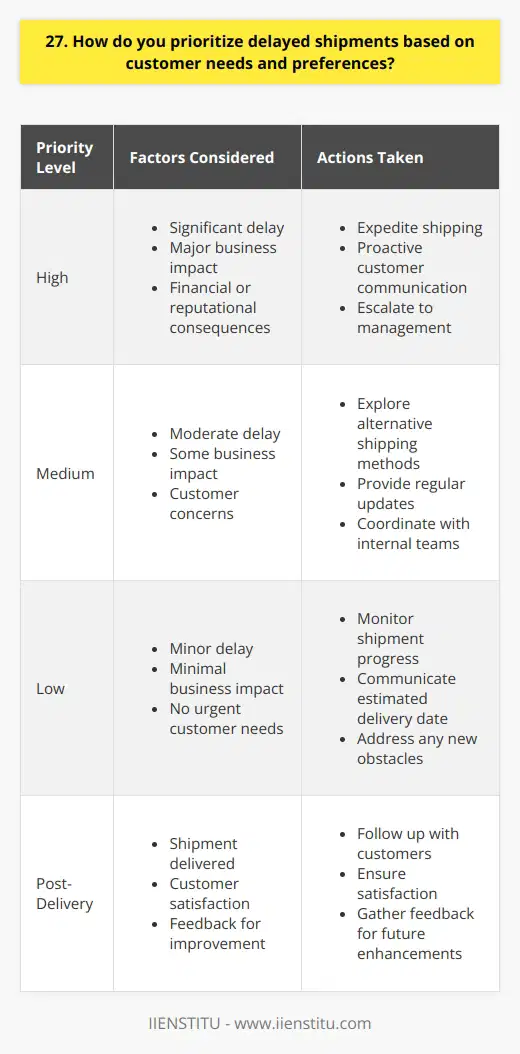
28. What processes do you have in place to handle delayed shipments that are returned or refused?
At our company, we have a comprehensive process in place to handle delayed shipments that are returned or refused.
Communication is Key
First and foremost, we maintain open lines of communication with our customers. If a shipment is delayed, we promptly inform the customer and provide an updated estimated delivery date. We also offer the option to cancel the order if the delay is unacceptable to the customer.
Tracking and Monitoring
We utilize advanced tracking systems to monitor the progress of each shipment. This allows us to quickly identify any potential delays and take proactive measures to mitigate them. Our team works closely with our shipping partners to ensure that any issues are resolved as quickly as possible.
Returned or Refused Shipments
In the event that a delayed shipment is returned or refused by the customer, we have a streamlined process in place. Once the package is received back at our warehouse, we immediately notify the customer and offer a full refund or the option to reship the order at no additional cost.
Quality Control
Before reshipping any returned or refused orders, we carefully inspect the products to ensure they meet our high standards. If any items are damaged or defective, we replace them with new ones. We take pride in delivering quality products to our customers, even in the face of delays.
Continuous Improvement
We are always looking for ways to improve our processes and prevent delayed shipments from occurring in the first place. We regularly review our shipping procedures and partner with reliable carriers who have a proven track record of on-time delivery. By continuously refining our approach, we aim to minimize delays and ensure customer satisfaction.
In my experience, effective communication, proactive monitoring, and a customer-centric approach are the keys to successfully handling delayed shipments. Our team is dedicated to going above and beyond to make things right for our customers, no matter the circumstances.
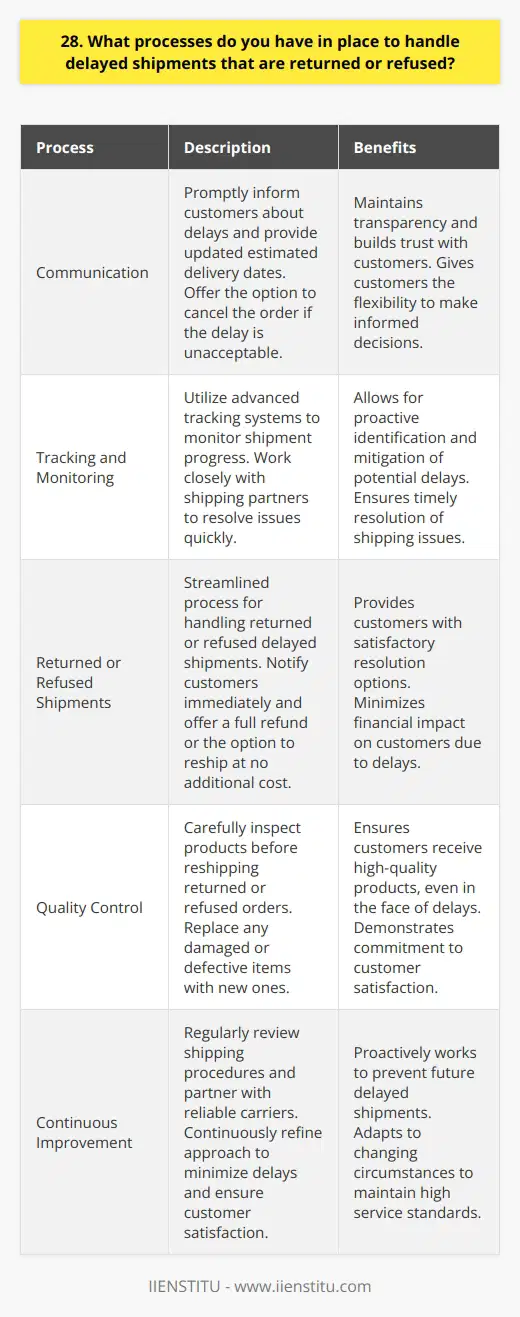
29. How do you use customer feedback to improve your processes for handling delayed shipments?
At my previous job in an e-commerce company, we prioritized customer satisfaction above all else. Whenever a shipment was delayed, we would immediately reach out to the affected customers and inform them of the situation. We would also offer them options such as a refund, a discount on their next purchase, or expedited shipping at no extra cost.
Analyzing Customer Feedback
We regularly collected and analyzed customer feedback through surveys, emails, and phone calls. This helped us identify the root causes of delayed shipments, such as issues with our suppliers, inventory management, or shipping carriers. Based on this feedback, we would work on implementing solutions to prevent similar delays in the future.
Improving Our Processes
One example of how we used customer feedback to improve our processes was when we noticed a pattern of delays from a particular supplier. We reached out to them and discovered that they were experiencing a shortage of raw materials. We worked with them to find alternative sources and adjusted our inventory levels accordingly. As a result, we were able to reduce delays from that supplier by 80%.
Communicating with Customers
We also used customer feedback to improve our communication with customers. Many customers expressed frustration with the lack of updates on their delayed orders. In response, we implemented a system that automatically sent out daily updates to customers with the latest information on their shipment status. This helped reduce customer inquiries and improve overall satisfaction.
In summary, I believe that actively seeking and incorporating customer feedback is crucial for improving processes and handling delayed shipments effectively. It helps identify problems, find solutions, and ultimately enhance the customer experience. That's something I would bring to this role if given the opportunity.

30. What steps do you take to ensure delayed shipments are delivered with proper documentation and labeling?
When faced with a delayed shipment, I take immediate action to ensure proper documentation and labeling. Here are the steps I follow:
Communicate with the Customer
I always keep the customer informed about the status of their delayed shipment. I provide regular updates and an estimated delivery date. Clear communication helps maintain trust and understanding.
Review Documentation
I carefully review all documentation related to the delayed shipment. This includes invoices, packing slips, and shipping labels. I make sure everything is accurate and complete. If anything is missing or incorrect, I quickly address it.
Verify Labeling
Proper labeling is crucial for a smooth delivery process. I double-check that all labels are clear, legible, and securely attached. I ensure the correct shipping address, contact information, and any special handling instructions are included.
Coordinate with Shipping Partners
I work closely with our shipping partners to expedite the delivery of delayed shipments. I provide them with all necessary documentation and labeling. I also follow up regularly to track progress and resolve any issues that may arise.
By following these steps, I can confidently say that I do everything possible to ensure delayed shipments reach their destination with proper documentation and labeling. It's a challenging situation, but I approach it with a positive attitude and a focus on customer satisfaction.
